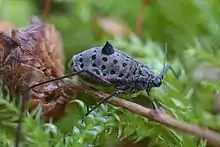Tuberolachnus salignus
Tuberolachnus salignus, or the giant willow aphid, is a species of aphid, in the genus Tuberolachnus. They are reputed to be the largest aphids, with a body length of up to 5.8mm.[1][2] First described by Johann Friedrich Gmelin in 1790, it feeds on many species of willow (Salix species), and has one known specific parasite, Pauesia salignae.[2]
| Tuberolachnus salignus | |
|---|---|
 | |
| Tuberolachnus salignus, showing dorsal tubercle | |
| Scientific classification | |
| Kingdom: | |
| Phylum: | |
| Class: | |
| Order: | |
| Suborder: | |
| Superfamily: | |
| Family: | |
| Genus: | |
| Species: | T. salignus |
| Binomial name | |
| Tuberolachnus salignus Gmelin, 1790 | |
Tuberolachnus salignus does not require a male for reproduction. Only females have ever been recorded, which suggests that reproduction is parthenogenetic and all offspring produced are genetically identical clones.[3]
Host plants
Tuberolachnus salignus is known to feed primarily on willow and Salix tree species such as the white willow (Salix alba), the common sallow (Salix cinerea')[3] and the Indian willow (Salix tetrasperma).[4] The following host tree species have also been recorded:
References
- "Tuberolachnus salignus". Retrieved 26 November 2016.
- "Giant Willow Aphid (Tuberolachnus salignus) Have we solved one of its mysteries?". Retrieved 26 November 2016.
- "Tuberolachnus salignus Giant willow aphid". Influential Points. 2023-02-12. Retrieved 2023-02-12.
- Hussain, Barkat & War, Abdul Rasheed & Singh, Satnam & Ahmad, Shanawaz. (2021). First Record of an Invasive Pest, Giant Willow Aphid, Tuberolachnus salignus (Gmelin) (Hemiptera: Aphididae) on Salix alba in the Cold Arid Region of Ladakh, India. Entomological News. 129. 10.3157/021.129.0508.
- Horton, Helena (2023-02-12). "Have you seen this bug? Scientists call on Britain's gardeners to track elusive aphid". The Guardian. Retrieved 2023-02-12.
Further reading
- Collins, C. Matilda; Leather, Simon R. (2001). "Effect of temperature on fecundity and development of the Giant Willow Aphid, Tuberolachnus salignus (Sternorrhyncha: Aphididae)". European Journal of Entomology. 98 (2): 177–182. doi:10.14411/eje.2001.033. ISSN 1210-5759.
- Collins, 1C Matilda; Rosado, Rui G.; Leather, Simon R. (2001). "The impact of the aphids Tuberolachnus salignus and Pterocomma salicis on willow trees". Annals of Applied Biology. 138 (2): 133–140. doi:10.1111/j.1744-7348.2001.tb00095.x. ISSN 0003-4746.
- Mittler, T.E. 1957: Studies on the feeding and nutrition of Tuberolachnus salignus (Gmelin) (Homoptera, Aphididae) I. The uptake of phloem sap. Journal of Experimental Biology, 34: 334-341. Abstract and full article (PDF)